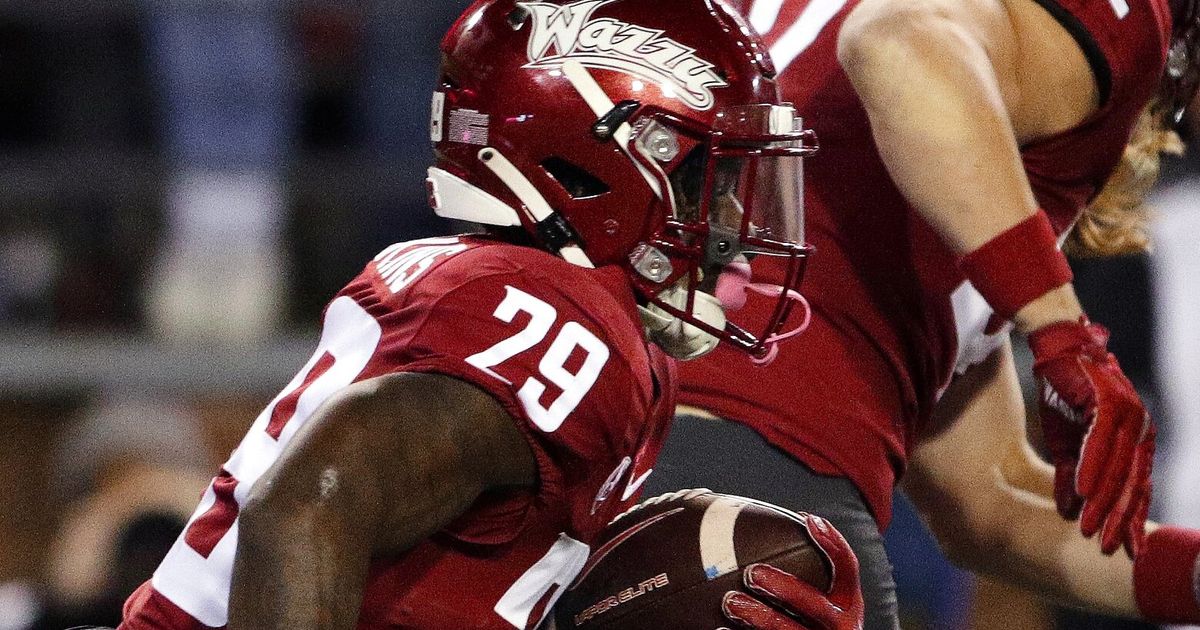
PULLMAN — When Washington State installed a new version of the typically pass-heavy Air Raid offense this preseason, the Cougars stressed the importance of maintaining a healthy ground game.
WSU planned to run the ball on about 40% of its plays. The team’s running back room didn’t include much experience, but the Cougars were confident they would have enough capable ball-carriers to chip away at opposing defenses and take some pressure off quarterback Cameron Ward.
But the ground game isn’t providing much relief this season. The Cougars’ rushing attack couldn’t stay healthy. Through eight games, WSU has been the least-productive rushing team in the Pac-12, ranking last in the conference in yards per game (83.5) — 20 yards back of 11th place — yards per carry (3.5), attempts (193) and touchdowns (six).
“We really want to up that number so people have to come down and respect us running the football,” WSU coach Jake Dickert said Monday, adding later: “Right now, we’re not establishing the run enough.”
The Cougars’ tailback room is depleted and it’s unclear how WSU (4-4, 1-4 Pac-12) will distribute the reps at running back when it visits Stanford (3-5, 1-5) at 12:30 p.m. Saturday.
Starter Nakia Watson, the Cougars’ third-stringer last year, suffered an injury Oct. 8 at USC and is sidelined indefinitely. Reserve running back Kannon Katzer entered the transfer portal after WSU’s loss to Oregon State on Oct. 15.
Two running backs were set to share the snaps for WSU on Thursday against Utah: true freshman Jaylen Jenkins, the No. 2 tailback throughout the year, and redshirt freshman Dylan Paine, who occupied the fourth position on the depth chart for the first half of the season before making his offensive debut versus the Beavers. But Jenkins went down with an injury in the second quarter against the Utes and his status for Saturday’s game is uncertain.
Paine was put to work mostly as a blocker and check-down option in the passing game against Utah. He had three receptions for 29 yards and logged 10 yards on two carries. Dickert extended kudos to Paine for picking up “some tough yards.” But the coach didn’t give any guarantees when asked whether Paine would start at tailback if Jenkins was unavailable Saturday.
“You might see anyone out there,” Dickert said. “Whoever we put back there and however we shape it, we gotta be ready to go.”
Should the Cougars promote a deep-reserve into a potential playing role, they will presumably select true freshman Djouvensky Schlenbaker, who took part in the preseason competition for the backup job but fell out of the race and has yet to see the field this year.
Perhaps WSU dials up a few more QB runs for Ward, who saw his rushing duties expand Thursday due to a lack of depth at tailback.
Ward led the team in rushing. Excluding four sacks — and the 41 yards lost from sacks — Ward took eight carries for 59 yards and a touchdown.
“I thought he ran with more authority,” Dickert said of Ward. “We had some designed runs for him.”
WSU’s ground game has been held under 70 yards in five games. The Cougars compiled over 100 yards on the ground on three occasions, with a season high of 144 yards against USC — Jenkins had a breakout performance in relief of Watson.
In terms of net yardage, the Cougars are coming off their two worst rushing games of the season. They were held to 23 yards on 20 carries against Oregon State and 42 yards on 19 rushes versus Utah. WSU lost 79 rushing yards on 10 sacks combined in those two games.
To be sure, sacks are playing a part in the Cougars’ low rushing numbers — they have surrendered a conference-high 30 sacks — but running lanes have been noticeably sparse, so WSU is often forced to lean on their aerial attack. The Cougars have elected to pass on 65% of their plays.
“As we go through (possessions), we have to stay committed to the run,” Dickert said. “That’s first-and-10 and within, that’s hopefully getting some positive yards on second down and being more balanced, and trusting some of those pieces in there to go get those tough yards. You gotta establish the run. It’s what we want to do.”
Stanford ranks 10th in the conference in rushing defense with 204.6 yards allowed per game. The Cardinal have given up 300 rushing yards in two games and surrendered 150 or more in all but one game.